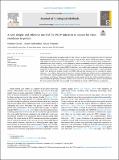Files in this item
A new simple and effective method for PLRV infection to screen for virus resistance in potato
Item metadata
| dc.contributor.author | Cowan, Graham | |
| dc.contributor.author | MacFarlane, Stuart | |
| dc.contributor.author | Torrance, Lesley | |
| dc.date.accessioned | 2023-03-24T11:30:06Z | |
| dc.date.available | 2023-03-24T11:30:06Z | |
| dc.date.issued | 2023-05-01 | |
| dc.identifier | 283576493 | |
| dc.identifier | 3580abb1-f1ae-4ab0-858b-778fac88925e | |
| dc.identifier | 36787852 | |
| dc.identifier | 85148645847 | |
| dc.identifier.citation | Cowan , G , MacFarlane , S & Torrance , L 2023 , ' A new simple and effective method for PLRV infection to screen for virus resistance in potato ' , Journal of Virological Methods , vol. 315 , 114691 . https://doi.org/10.1016/j.jviromet.2023.114691 | en |
| dc.identifier.issn | 0166-0934 | |
| dc.identifier.uri | https://hdl.handle.net/10023/27260 | |
| dc.description | Funding: This work was funded by the Scottish Government Rural and Environment Science and Analytical Services Strategic Research Programme 2022–2027 (Project Ref. JHI-B1-1). | en |
| dc.description.abstract | Effective screening of plant germplasm collections for resistance to plant viruses requires that there is a rapid and efficient system in place to challenge individual plants with the virus. Potato leafroll virus (PLRV), a commercially important pathogen of potato, is able naturally to infect only the phloem-associated tissue of plants and is delivered to this tissue by feeding aphids. Mechanical (non-vector-mediated) infection by PLRV does not occur thus screening for PLRV resistance is currently laborious and time consuming. We constructed an infectious cDNA clone of a new (Hutton) isolate of PLRV in the binary vector pDIVA and transformed it into Agrobacterium tumefaciens strain LBA4404. Infiltration of this culture into leaves of Nicotiana benthamiana, a highly susceptible model plant, produced a systemic infection with PLRV, although this approach was not successful for potato. However, a very efficient and reproducible systemic infection of potato was achieved when we submerged cut stems of the plant into the agrobacterium cell suspension and then transplanted the stems into compost to grow roots and new apical leaves. Using a standardised protocol developed for this new PLRV inoculation method we have confirmed the previously described resistance to the virus in the JHI breeding line G8107(1) and identified 62 plant accessions from the Commonwealth Potato Collection in which no PLRV infection was detected. | |
| dc.format.extent | 5 | |
| dc.format.extent | 2252205 | |
| dc.language.iso | eng | |
| dc.relation.ispartof | Journal of Virological Methods | en |
| dc.subject | Potato leafroll virus | en |
| dc.subject | PLRV | en |
| dc.subject | Virus resistance | en |
| dc.subject | Infectious clone | en |
| dc.subject | Commonwealth Potato Collection | en |
| dc.subject | DAS | en |
| dc.subject | NIS | en |
| dc.subject | MCC | en |
| dc.title | A new simple and effective method for PLRV infection to screen for virus resistance in potato | en |
| dc.type | Journal article | en |
| dc.contributor.institution | University of St Andrews. School of Biology | en |
| dc.contributor.institution | University of St Andrews. Biomedical Sciences Research Complex | en |
| dc.identifier.doi | 10.1016/j.jviromet.2023.114691 | |
| dc.description.status | Peer reviewed | en |
This item appears in the following Collection(s)
Items in the St Andrews Research Repository are protected by copyright, with all rights reserved, unless otherwise indicated.

